It's a Great Day to Bird
Month: November 2014
Members of our local birding group (Kachemak Bay Birders) met at the base of the Homer Spit on Saturday, November 22 to spend a couple of hours roaming birding hot spots along the Spit while enjoying the sun and warm weather (okay mid 30s, but the wind was calm for most of the trip). At one point, I counted 20 intrepid birders – some of them first timers. We were all energized by the winter sun on our rosy cheeks and birds in our binoculars. No ice covered pools of water or frozen hands for us. Yes, looks like green grass for turkey day. Homer is indeed the banana belt…..
Our group, lead by our always alert leader observed a grand total of 32 species – not a bad day for such a small area.
Our first stop was Mud Bay, famous for its shorebirds and always good for waterfowl in the winter. The duckies were in good shape this year – generally by this time of year we have snow on the ground and ice on the mud flats. Not so this year.
Many of the birds were on the bay and out a ways, so my ability to take decent (or any) photos was limited. Near the Boat Harbor we did spot a large flock of Gray-crowned Rosy-finches flitting about. We only see these birds during the winter months when then come down from their breeding grounds in alpine areas. There are six subspecies of Gray-crowned Rosy-finches (Leucosticte tephrocotis) of which four breed in Alaska.
When the weather is really nasty (blowing snowy and cold), these birds come to our home feeder in droves (up to 250 or so). Most times they are seen mainly on the Homer Spit.
Some, okay all of us, were hoping the Snowy Owl spotted earlier in the week would make an appearance, but we head to settle for a different snowbird – Snow Buntings. Not to be sneezed at, these are pretty cool birds too. There was a flock of 20+ buntings at Green Timbers searching for food among the grass and driftwood. We only see these birds during the winter also. In the summer they nest in the high arctic.
Did you know the male Snow Bunting undergoes only one molt in the fall? So how come they look so different in the summer ? Well the male wear off all of the feather tips by rubbing them in the snow. By the breeding season the male’s feathers are white and black. For photos of Snow Buntings in the summer check out: http://www.allaboutbirds.org/guide/Snow_Bunting/id.
On the bay there were some Long-tailed Ducks (formerly known as Old Squaw). I love their call (check out: http://www.allaboutbirds.org/guide/Long-tailed_Duck/sounds), and these guys were calling. While I was able to get a few photos, the photos do not do the birds justice (camera limitations and distance of bird from the shoreline).
This diving duck breeds in the high arctic and winters along the coasts of the United States. A good size flock generally spends the winter in Kachemak Bay, particularly along the spit where food from fish processing plants is plentiful at times.
Of course what is the Spit without its resident Bald Eagle population. This Bald Eagle was enjoying an afternoon meal upon a metal dolphin near the tip of the spit (Land’s End for those in the know).
We also found a flock of Rock Sandpipers roosting along a berm. Rock Sandpipers are one hardy bird – we enjoy them all winter long. They often roost inside the calm water/banks of the Homer Small Boat Harbor, and even as the boat harbor freezes up the birds can be found there taking a bath.
Here is a list of the species we saw on our field trip:
COMMON LOON
RED-NECKED GREBE
HORNED GREBE
PELAGIC CORMORANT
HARLEQUIN DUCK
EURASIAN WIGEON
AMERICAN WIGEON
COMMON GOLDENEYE
GREEN-WINGED TEAL
MALLARD
LONG-TAILED DUCK
NORTHERN PINTAIL
WHITE-WINGED SCOTER
BLACK SCOTER
SURF SCOTER
GLAUCOUS-WINGED GULL
MEW GULL
BLACK-LEGGED KITTIWAKE
COMMON MURRE
MARBLED MURRELET
PIGEON GUILLEMOT
ROCK SANDPIPER
BALD EAGLE
ROCK PIGEON
BLACK-BILLED MAGPIE
NORTHWESTERN CROW
COMMON RAVEN
BOREAL CHICKADEE
GOLDEN-CROWNED KINGLET
SONG SPARROW
GRAY-CROWNED ROSY FINCH
SNOW BUNTING
If you want to learn more about the Kachemak Bay Birders, check out their website at: http://kachemakbaybirders.org/. The group’s next scheduled field trip is set for January 17th – Leader’s Choice (so it could be almost anywhere). Interested persons should meet at the Islands and Ocean Visitor Center parking lot at 12:00 – noon.
In Mid-November (on a gray and windy day), I spotted a Killdeer along the Anchor River. This is a surprise find at any time of the year.
In the same general area were two Sanderlings feeding along the river. They are a long way from their winter home.
A good size flock of Rock Sandpipers winter in the Homer area, feeding along the spit, and roosting in the boat harbor. A smaller flock can generally be found along the beaches at Anchor Point. The highest number I have observed so far this fall has been around 70 or so. These sandpipers at Anchor Point may be migrating northward to winter in Upper Cook Inlet.
As I was watching the sandpipers, a Northwestern Crow would fly over the shorebirds and flush them. The crow would then land and begin to feed. Guess the crow did not want the competition. Further up the beach, more Northwestern Crows were feeding along the surf line, along with two adult Bald Eagles. The adult eagles were feeding on some dead critter, most likely a fish.
One of my favorite beaches for shorebirds on the Kenai Peninsula is the beach at Anchor Point. I go there quite frequently year-round, although less so during the winter. Winds can be be brutal, driving temperatures down.
I am at the beach monthly to perform COASST surveys for dead birds. During my six years of surveys I have observed a number of different shorebird species utilizing this beach. In the spring, I help monitor shorebirds as part of the Kachemak Bay Birders’ Shorebird Monitoring Project. Next spring will the third year this beach has been monitored as part of that project.
If you want to see a variety of shorebirds come between late April and late September. Fall or outbound migration begins as early as late June. Spring migration is best the first three weeks in May, with the best time around the second week of May. Species I have observed here include: Sanderling, Black Turnstone, Ruddy Turnstone, Surfbird, Rock Sandpiper, Least Sandpiper, Western Sandpiper, Semi-palmated Sandpiper, Sharp-tailed Sandpiper, Pectoral Sandpiper, American Golden Plover, Black-bellied Plover, Pacific Golden Plover, Semi-palmated Plover, Whimbrel, Marbled Godwit, Buff-breasted Sandpiper, Killdeer, and Bristle-thighed Curlew (rare).
Come and enjoy the shorebirds of Anchor Point beach.
I had to drive into town today for a meeting so I decided to go in early and stop off at Seaside Farm and the Homer Spit to see what birds were out and about.
At Seaside Farm there were lots of Northwestern Crows feeding on the ground and chasing each other. Fun to watch.
Also present were American Robins, Bohemian Waxwings, a Red-breasted Nuthatch, Pine Siskins, and Black-capped Chickadees. The day was sunny and warm.
After leaving Seaside Farms I headed to the Spit. There had been an earlier report of Snow Buntings at Green Timbers. I stopped to check out the Mallards and American Wigeons in Mud Bay first. As I was driving down to the parking lot at Green Timbers I said to myself “wouldn’t it be nice to see an owl”. I was thinking of a Short-eared Owl which are occasionally seen this late in the year. It was pretty quiet at Green Timbers, but decided to get out and see if any Snow Buntings might flush as I walked north of the parking lot. I didn’t get too far when I looked up and spotted a Snowy Owl on a dead snag. I could not believe my eyes. Snowy Owls are periodically seen in Homer, but I have not been fortunate enough to see one until today. This is a life bird for me and one I’ve been waiting to see for some time. I wanted to do a little dance at my good fortune. As Jack likes to say – Timing is Everything.
I sat, photographed, and watched the bird for 15-20 minutes. Others had seen the owl and were also enjoying the sight. A Black-billed Magpie wasn’t too happy with the owl, but only halfheartedly tried to chase it off. Then a Common Raven decided to give a more concerted effort of chasing off the owl. The owl did leave its perch, but only flew to the ground.
I had to rush off to check on a winter flock of Rock Sandpipers at the Homer Boat Harbor and then to meet a friend for coffee (prearranged) before my meeting.
November 8, 2014 was the start date of this season’s annual Project FeederWatch – a winter-long survey (November – April) of birds visiting feeders in North America. This program is hosted by the Cornell Lab of Ornithology and Bird Studies Canada. According to the Cornell Lab of Ornithology website, the purpose of the program is to “help scientists track broadscale movements of winter bird populations and long-term trends in bird distribution and abundance”.
Participants, during two consecutive days each week, record the total number of a given species found at their feeder(s) at one time. So for instance, if I were to see 10 Gray-crowned Rosy-finches at my feeder at 10:00 am on count day, and then an hour later count 75 Gray-crowned Rosy-finches (yes, that many have visited my feeder in the past) I would record the 75 Gray-crowned Rosy-finches observed for that day.
Participants are also asked to record additional information during the count period, such as temperature, precipitation, amount of snow/ice on the ground, and how much time spent observing one’s feeder .
If you enjoy feeding and watching birds, why not help contribute to science by recording and reporting information about what birds come to your feeder. Become one of about 20,0000 citizen scientist participating in Project FeederWatch. There is a cost for participating: $18 for U.S. Residents and $15.00 if you are a Cornell Lab of Ornithology member. The cost goes to cover expenses associated with operating the program. For more information go to: http://feederwatch.org/

Pine Grosbeaks at a my feeder on a balmy day (44 degrees F) near Homer, Alaska. November 12, and no snow.
Birds I typically get at my feeder in the winter include Pine Grosbeaks, Gray-crowned Rosy-finches (generally when it is really storming outside), Common Redpolls, Gray Jays, Black-billed Magpies, and an occasional Black-capped Chickadee. Not many species (of course, I live at around 1400 feet elevation), but I have had up to around 250 Gray-crowned Rosy-finches at my feeder at one time. Pretty amazing to watch these birds flit about and not hit my windows (a future blog). They always seem to be on the move, and you have to wonder if they even have time to get any food. Maybe only a few do at a time. Happy feeder watching.
I’ve decided to write a blog about my experiences birding in Alaska and around the world. I will also write about bird-related issues near and dear to my heart. I hope you enjoy the blog. Please feel free to comment, and to share this blog with other like-minded birders (or not).
© 2024 alaskabirder
Theme by Anders Noren — Up ↑









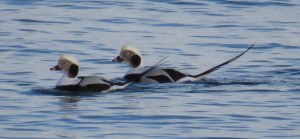


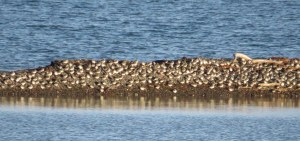






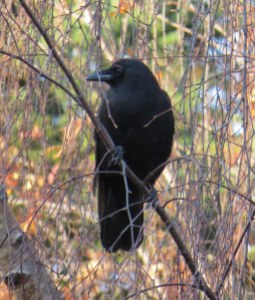

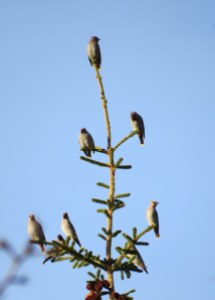


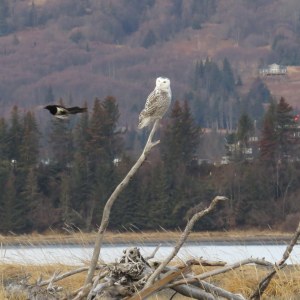
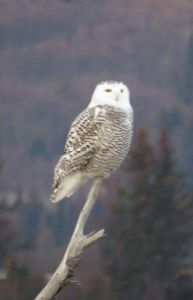
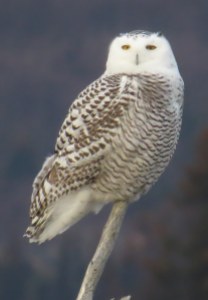


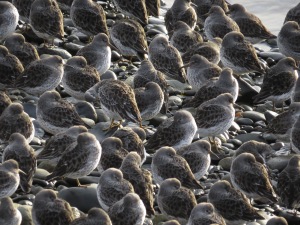

Recent Comments